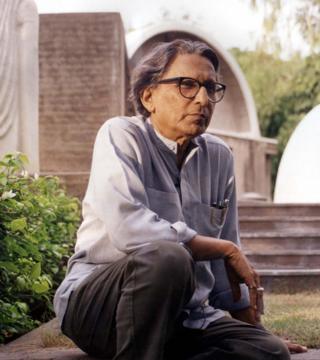Balkrishna Doshi: Indian wins prestigious Pritzker Prize
 Image copyright
COURTESY: VSF
Image copyright
COURTESY: VSF
Ninety-year-old Indian architect Balkrishna Doshi has won this year's prestigious Pritzker Prize for his pioneering work in low-cost housing.
He is the first Indian to receive the award, considered to be architecture's highest honour.
Doshi studied in Mumbai before travelling to Paris in the 1950s to work for the Franco-Swiss pioneer, Le Corbusier.
He will be awarded $100,000 (£80,591) at a ceremony in Toronto in May.
Previous winners include Jørn Utzon who designed the Sydney Opera House, Oscar Niemeyer of Brazil and the British-Iraqi designer, Zaha Hadid.
"Balkrishna Doshi has always created an architecture that is serious, never flashy or a follower of trends," said the Pritzker jury.
The jury added that Doshi "constantly demonstrates that all good architecture and urban planning must not only unite purpose and structure but must take into account climate, site, technique, and craft, along with a deep understanding and appreciation of the context in the broadest sense".
"Projects must go beyond the functional to connect with the human spirit through poetic and philosophical underpinnings."
Doshi thanked the jury and said in a statement that his works "are an extension of my life, philosophy and dreams trying to create treasury of the architectural spirit".
- The battle to save Mumbai's art deco buildings
- The fight to save Kolkata's heritage homes
- Pritzker Architecture Prize 2013 goes to trio from Catalonia
"Every object around us, and nature itself - lights, sky, water and storm - everything is in a symphony," Doshi was quoted as saying by the AFP news agency.
"This symphony is what architecture is all about."
Indian Prime Minister Narendra Modi took to Twitter to congratulate him.
Doshi's wide ranging work in buildings include institutions, mixed-use complexes, housing projects, public spaces, galleries, and private residences.
He designed a top management school in the southern city of Bangalore and a well-known low cost housing scheme in the central city of Indore.
More than 6,500 homes in the Indore scheme now house some 80,000 low to middle income people. A system of houses, courtyards and a labyrinth of internal pathways make it one of the most notable low cost housing schemes in India.
"It seems I should take an oath and remember it for my lifetime: to provide the lowest class with the proper dwelling," Doshi said in 1954.
He became one of the most influential architects of post-independence India, fusing international modernist principles with local traditions.
Doshi began studying architecture in 1947, the year India gained Independence, at Mumbai's famous Sir JJ School of Architecture.
Working under Le Corbusier, he returned to India in 1954 and worked on the Modernist guru's projects in the cities of Chandigarh and Ahmedabad.
Doshi also collaborated with Louis Kahn, another of the 20th century's Modernist giants.